Gammon India Ltd. Bundle
Who Really Owns Gammon India Ltd. Today?
Unraveling the ownership of Gammon India Ltd. is key to understanding its past, present, and future. Major shifts in ownership can redefine a company's destiny, making it critical to know who calls the shots. This analysis dives deep into the Gammon India Ltd. SWOT Analysis to uncover the key players and their influence.
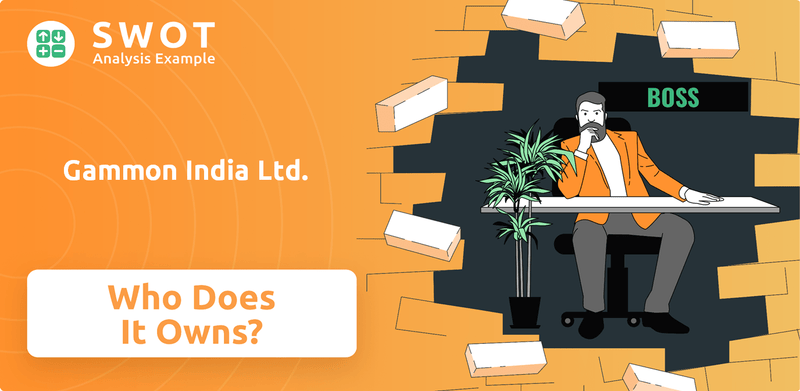
From its inception in 1922, Gammon India's history is intertwined with India's infrastructure development. Understanding the Gammon India ownership structure, from its founders to its current shareholders, offers insights into its strategic direction and financial performance. This exploration of Gammon India shareholders and their impact is essential for anyone tracking the company's journey, especially considering recent changes in its stock and market presence. The Gammon India parent company and its subsidiaries also play a crucial role.
Who Founded Gammon India Ltd.?
The story of Gammon India Ltd. begins in 1922, with its founder, John C. Gammon, a British engineer. He laid the groundwork for the company after working in India's Public Works Department and contributing to significant projects like the Gateway of India.
Early on, the Gammon family played a crucial role in the company's development. While specific initial shareholding details are not readily available in recent public records, the family's influence was a key factor in the company's early development and control.
The company's early operations expanded across the Commonwealth, Asia, and West Africa, showcasing its global ambitions from the start. The Gammon family maintained a significant interest in the company for many years.
John C. Gammon, a British engineer, founded Gammon India Ltd. in 1922. Before establishing the company, he worked in the Public Works Department of India.
John C. Gammon was involved in the construction of the Gateway of India. This project marked the first pre-cast reinforced concrete piling job in the country.
The Gammon family held a significant interest in the company for many years. Peter Gammon, from the original Gammon family, was the chairman emeritus as of 2009.
Historically, a quarter of the company's equity was held in the UK. This was equally divided between two branches of the Gammon family.
Gammon India Ltd. expanded its operations across the Commonwealth, Asia, and West Africa. This early expansion showed the company's global ambitions.
Specific details on the initial equity split are not readily available in recent public records. However, the family's influence was a key factor in the company's early development and control.
Understanding the early history of Gammon India Ltd. provides insights into its foundations. The company's early success was significantly shaped by its founder and the Gammon family's involvement. For more information, consider exploring the Marketing Strategy of Gammon India Ltd.
- John C. Gammon founded the company in 1922.
- The Gammon family maintained a significant interest in the company.
- Early projects included the Gateway of India.
- The company expanded operations globally.
Gammon India Ltd. SWOT Analysis
- Complete SWOT Breakdown
- Fully Customizable
- Editable in Excel & Word
- Professional Formatting
- Investor-Ready Format
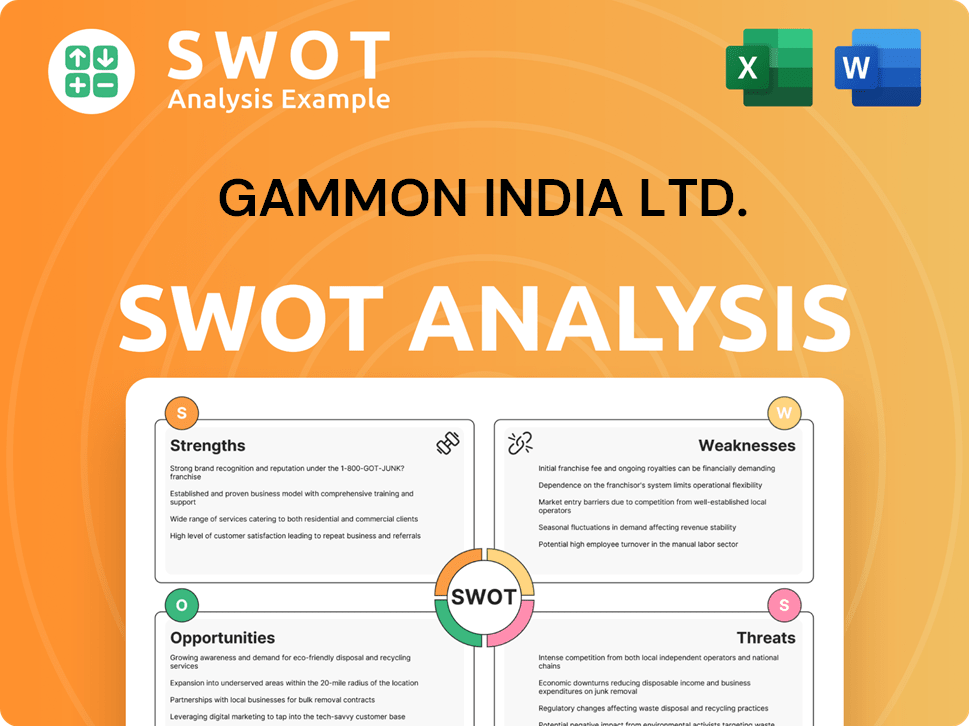
How Has Gammon India Ltd.’s Ownership Changed Over Time?
The ownership of Gammon India Ltd. has seen considerable shifts since its inception, evolving from a family-led entity to one significantly influenced by financial institutions. The Growth Strategy of Gammon India Ltd. has been impacted by these changes. As of December 2023, the promoter holding stood at 11.54%, with a substantial portion, around 84.75%, of these shares pledged. This indicates the financial strain the company has faced, influencing its ownership structure.
The early ownership structure, as of 1988, showed a significant public shareholding of 61%, with financial institutions holding 6% and directors and employees holding 8%. However, by November 2015, a Strategic Debt Restructuring (SDR) scheme converted a portion of the debt into equity, leading to lenders acquiring approximately a 62% equity stake. This was a pivotal moment, shifting control towards lenders and reflecting the company's financial challenges and the need for debt resolution. The company's annual report for fiscal year ended March 31, 2024, references a Corporate Debt Restructuring (CDR) package of Rs 13,500 crore approved by lenders in July 2013, which likely led to further dilution of original promoter holdings.
| Ownership Category | December 2023 | Notes |
|---|---|---|
| Promoter Holding | 11.54% | 84.75% of shares pledged |
| Institutional Investors | 63.70% | Remained unchanged |
| FII/FPI Holding | 1.16% |
The financial instability of Gammon India Ltd., marked by a high debt-to-equity ratio in 2024 and significant net losses, underscores the ongoing influence of lenders and institutional stakeholders in its governance and strategic direction. The shareholding pattern reflects the company's history and its responses to financial pressures.
Gammon India's ownership has transitioned significantly due to financial restructuring. Institutional investors hold a major stake, reflecting the impact of debt resolution strategies. The promoters' stake has been diluted over time, with a significant portion pledged.
- Promoter holding at 11.54% as of December 2023.
- Institutional investors held 63.70% in December 2023.
- Financial distress led to significant debt restructuring.
- The company has faced high debt-to-equity ratios.
Gammon India Ltd. PESTLE Analysis
- Covers All 6 PESTLE Categories
- No Research Needed – Save Hours of Work
- Built by Experts, Trusted by Consultants
- Instant Download, Ready to Use
- 100% Editable, Fully Customizable
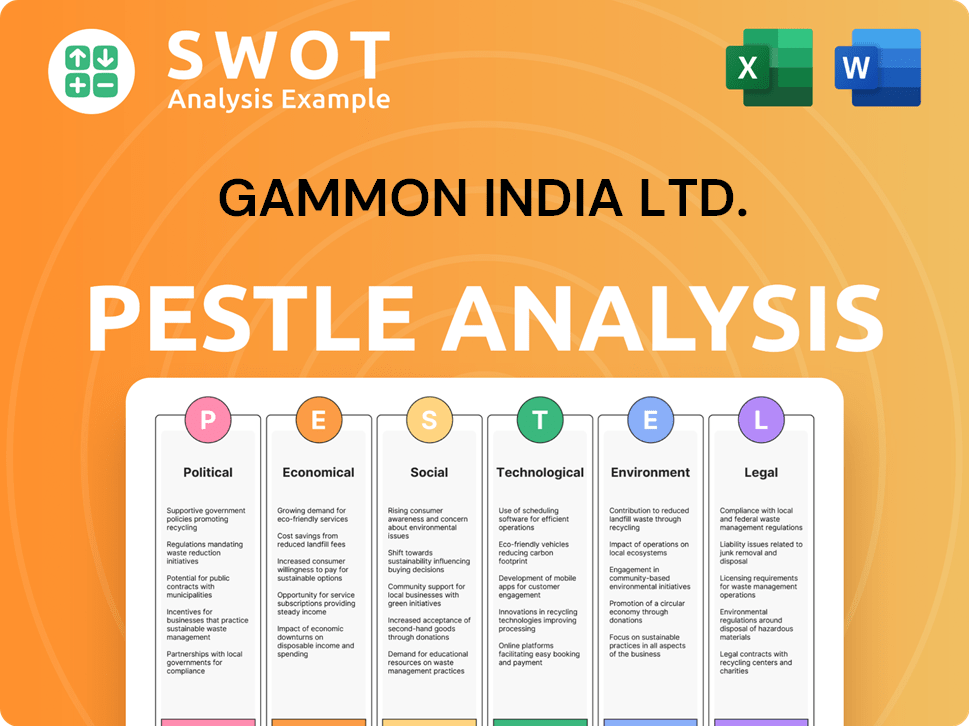
Who Sits on Gammon India Ltd.’s Board?
The Board of Directors of Gammon India Ltd. has seen recent changes, reflecting the company's ongoing efforts to strengthen its governance. As of March 28, 2024, the company appointed Mr. Radhakrishnan Nair and Mr. Mahendra Ujamshi Shah as Independent Directors. Mr. Shah brings over 40 years of experience in infrastructure and real estate, while Mr. Nair has 35 years of experience in construction project planning and execution. These appointments are strategic moves to bring in experienced professionals to provide independent oversight. Prior to these appointments, Mr. Soumendra Nath Sanyal ceased to be an Independent Director on March 31, 2024, due to his unwillingness for reappointment. Additionally, Mr. Ramchandra Balkrishna Bhatkar was recommended for appointment as an Independent Director, effective October 28, 2024, for a five-year term.
These changes are particularly relevant given the company's financial situation and the evolution of its Gammon India ownership structure. The board's composition and its decisions are critical for steering the company through its challenges and ensuring compliance with corporate governance norms. The board's activities, including the adoption of financial statements and appointment of a cost auditor, are detailed in annual reports and board meeting outcomes, such as the one held on November 30, 2024.
| Director | Role | Appointment Date |
|---|---|---|
| Radhakrishnan Nair | Independent Director | March 28, 2024 |
| Mahendra Ujamshi Shah | Independent Director | March 28, 2024 |
| Ramchandra Balkrishna Bhatkar | Independent Director | October 28, 2024 (recommended) |
The Gammon India shareholders and their voting power are significantly influenced by the company's shareholding pattern and the conversion of debt into equity. As of December 2023, promoter holding stood at 11.54%, with a substantial portion, 84.75%, pledged. The debt-to-equity conversion, which gave lenders approximately 62% equity, suggests that financial institutions likely hold considerable voting power. This structure prioritizes the interests of lenders and institutional investors in strategic and governance matters. For more insights, you can read Brief History of Gammon India Ltd..
The board's composition is evolving to include experienced independent directors.
- Significant influence from financial institutions due to debt-to-equity conversions.
- Promoter holdings are pledged, affecting voting dynamics.
- Board decisions are crucial for navigating financial challenges.
- The company's governance structure is shaped by its financial restructuring.
Gammon India Ltd. Business Model Canvas
- Complete 9-Block Business Model Canvas
- Effortlessly Communicate Your Business Strategy
- Investor-Ready BMC Format
- 100% Editable and Customizable
- Clear and Structured Layout
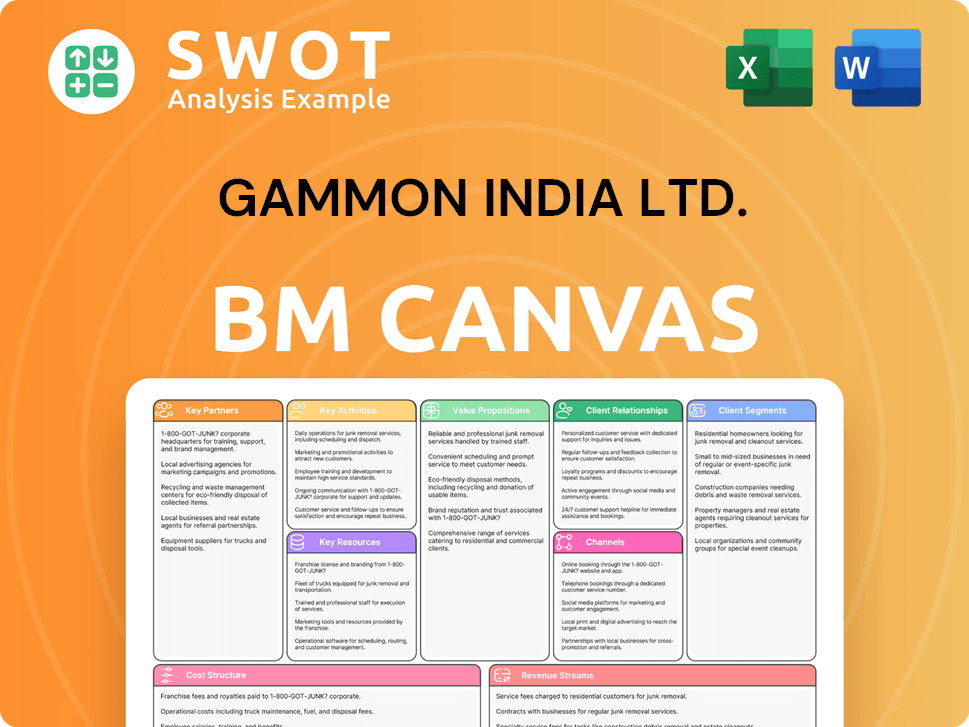
What Recent Changes Have Shaped Gammon India Ltd.’s Ownership Landscape?
Over the past few years, Gammon India Ltd. has undergone significant changes in its ownership structure and operational status. The most notable development is the delisting of its equity shares from both the Bombay Stock Exchange (BSE) and the National Stock Exchange (NSE). This delisting, finalized by April 2025, signifies a major shift, making the company's shares no longer available for trading on these major platforms. The company's equity shares were permanently suspended on the Metropolitan Stock Exchange (MSE) with effect from May 8, 2024. This transition is largely due to the company's financial distress and ongoing corporate insolvency resolution process.
The company is currently navigating a Corporate Insolvency Resolution Process (CIRP). Its wholly-owned subsidiary, Gactel Turnkey, was admitted for CIRP by the NCLT Mumbai Bench in April 2024. Gammon India itself has been involved in NCLT proceedings, with ongoing considerations regarding resolution plans and dissolution applications, as seen in NCLT Mumbai Bench listings for January 2025 and April 2025. These proceedings reflect the company's struggle with substantial debt and financial liabilities. The company's financial challenges have resulted in significant net losses, with ₹1,963 crore reported in March 2024, and a high debt-to-equity ratio.
| Metric | Details | Year |
|---|---|---|
| Delisting Date (NSE) | May 10, 2024 | 2024 |
| Delisting Date (BSE) | April 15, 2025 | 2025 |
| Net Loss (₹ Crore) | 1,963 | March 2024 |
| Institutional Investors Ownership | 63.70% | December 2023 |
Ownership trends in Gammon India ownership have been significantly influenced by debt restructuring efforts. In 2015, debt-to-equity conversions led to lenders holding approximately 62% equity. By December 2023, institutional investors held 63.70% of the company. This shift highlights a move away from traditional public shareholding towards ownership by financial institutions as part of the resolution of its substantial debt burden. The ongoing insolvency process and the involvement of lenders suggest that future ownership will be determined by the outcomes of resolution plans or liquidation proceedings.
The shareholding pattern has changed significantly due to debt restructuring. Institutional investors now hold the majority stake. The delisting from major stock exchanges further alters the shareholder landscape.
The stock is no longer traded on the BSE and NSE. This delisting impacts the accessibility of the stock for public investors. The focus is now on resolving the company's financial issues.
The company's history is marked by significant infrastructure projects. Recent events, including insolvency, have reshaped its trajectory. The delisting marks a critical turning point.
Gammon India's operations are currently focused on resolving financial liabilities. The parent company's involvement in the CIRP is a key element. The future ownership depends on the resolution.
Gammon India Ltd. Porter's Five Forces Analysis
- Covers All 5 Competitive Forces in Detail
- Structured for Consultants, Students, and Founders
- 100% Editable in Microsoft Word & Excel
- Instant Digital Download – Use Immediately
- Compatible with Mac & PC – Fully Unlocked
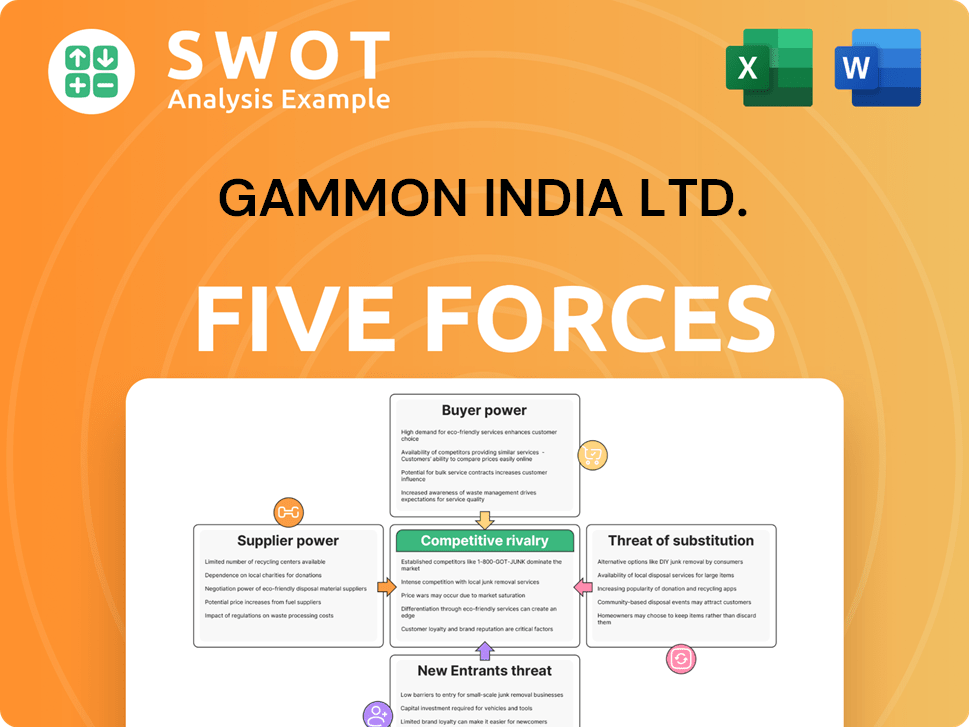
Related Blogs
- What are Mission Vision & Core Values of Gammon India Ltd. Company?
- What is Competitive Landscape of Gammon India Ltd. Company?
- What is Growth Strategy and Future Prospects of Gammon India Ltd. Company?
- How Does Gammon India Ltd. Company Work?
- What is Sales and Marketing Strategy of Gammon India Ltd. Company?
- What is Brief History of Gammon India Ltd. Company?
- What is Customer Demographics and Target Market of Gammon India Ltd. Company?
Disclaimer
All information, articles, and product details provided on this website are for general informational and educational purposes only. We do not claim any ownership over, nor do we intend to infringe upon, any trademarks, copyrights, logos, brand names, or other intellectual property mentioned or depicted on this site. Such intellectual property remains the property of its respective owners, and any references here are made solely for identification or informational purposes, without implying any affiliation, endorsement, or partnership.
We make no representations or warranties, express or implied, regarding the accuracy, completeness, or suitability of any content or products presented. Nothing on this website should be construed as legal, tax, investment, financial, medical, or other professional advice. In addition, no part of this site—including articles or product references—constitutes a solicitation, recommendation, endorsement, advertisement, or offer to buy or sell any securities, franchises, or other financial instruments, particularly in jurisdictions where such activity would be unlawful.
All content is of a general nature and may not address the specific circumstances of any individual or entity. It is not a substitute for professional advice or services. Any actions you take based on the information provided here are strictly at your own risk. You accept full responsibility for any decisions or outcomes arising from your use of this website and agree to release us from any liability in connection with your use of, or reliance upon, the content or products found herein.